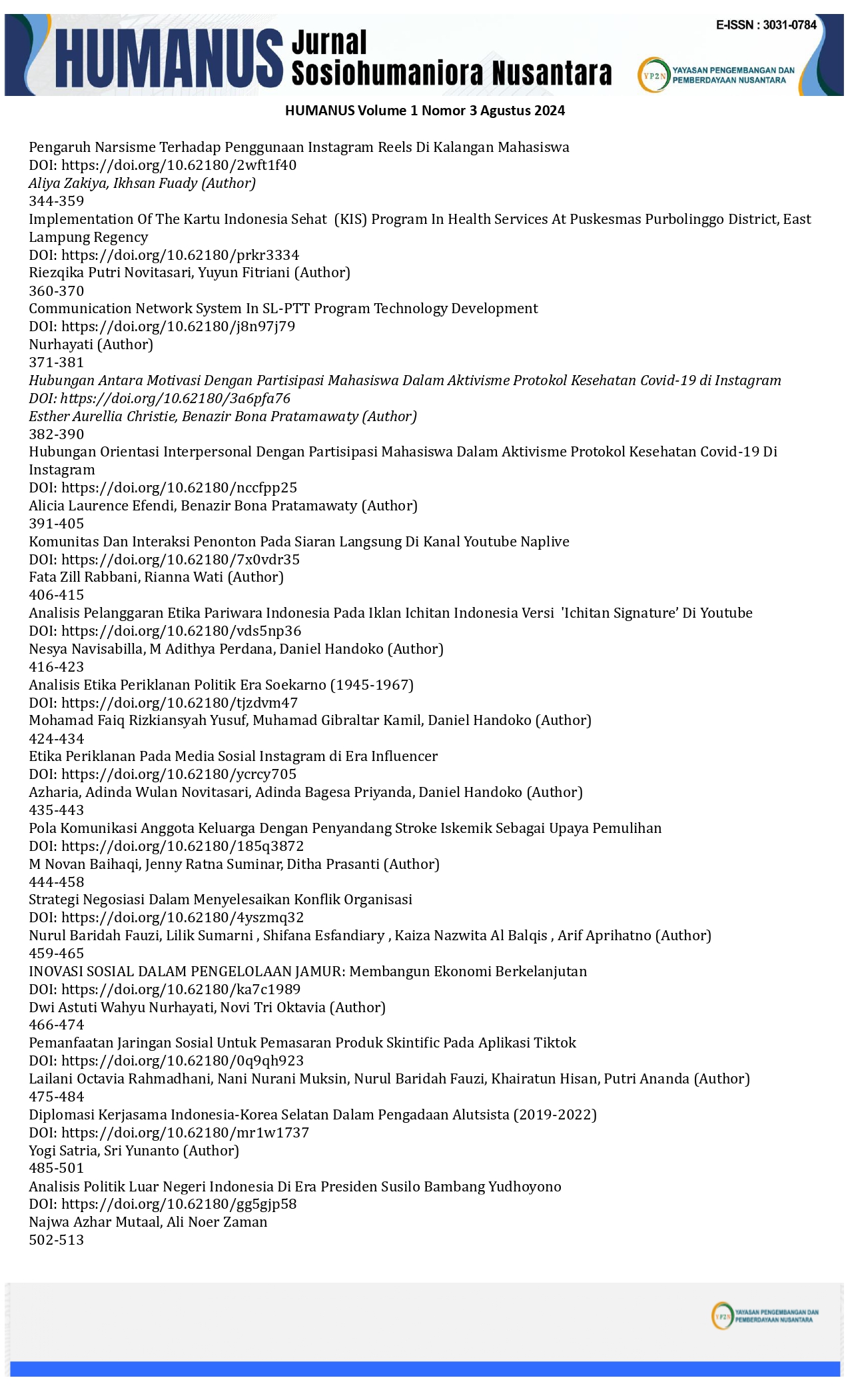Pola Komunikasi Anggota Keluarga Dengan Penyandang Stroke Iskemik Sebagai Upaya Pemulihan
DOI:
https://doi.org/10.62180/185q3872Keywords:
Interaksi , Komunikasi keluarga, Stroke IskemikAbstract
The nuclear family is the closest person who helps meet the daily needs of ischemic stroke sufferers. In their lives, ischemic stroke sufferers cannot be separated from interaction and communication with family members. The purpose of this study are: 1). To find out the interactions of family members with ischemic stroke as a recovery effort, 2). Knowing the reasons for communication with family members for ischemic stroke patient is needed as a recovery. This research is a qualitative with a case study approach. The data collection technique used observation and in-depth interviews. The number of resource persons is eight people consisting of six family members as resource persons and two health experts as well a stroke physiotherapist and a neurologist. This research uses Symbolic Interaction theory as a result analysis tool. The results showed that: 1). Interaction carried out by family members with people with ischemic stroke as recovery effort begins with involvement of all family members interacting with people with ischemic stroke regarding, daily activities, feelings and emotions of people with ischemic stroke, entertainment, and motivational sentences, then there are communication barriers, 2) The reasons for communicating with family members for people with ischemic stroke are needed as recovery effort, namely the patient feels more cared for, gives encouragement and motivation to recover in the patient, raises the patient's passion for life/mood, pays attention to healthy lifestyle, reduces the burden on the mind.
Downloads
References
American Heart Association. (2018). Heart Disease and Stroke Statistics_2018 Update: A Report From: The American Heart Association. Available From: Http://Circ.Ahajournals.Org/Cgi/Content/Full/121/7/E46. Diakses 1 Juli 2021 Pukul 13.00 WIB.
Arywibowo, J. D. (2023). Life After Stroke: Studi Fenomenologis Kualitas Hidup Penyintas Stroke di Indonesia. Collabryzk Journal for Scientific Studies, 2(1), 23-34.
Asilah, A & Hastuti, D. (2014). Hubungan tingkat stres ibu dan pengasuhan penerimaan penolakan dengan konsep diri remaja pada keluarga bercerai. Jurnal Ekologi, 7(1): 10-18. https://doi.org/10.24156/jikk.2014.7.1.10.
Avicenna. (2010). Perubahan Fisiologis Pasca Stroke. Jakarta: Rineka Cipta.
Creswell, J. W. (2014). Research Design: Qualitative and Quantitative Approach. Thousand Oaks : CA Sage.
Djamarah, B. S. (2004). Pola Komunikasi Orang Tua & Anak Dalam Keluarga. Jakarta : Rineka Cipta.
Effendy, Onong Uchjana. (2003). Ilmu, Teori dan Filsafat Komunikasi. Bandung: PT Citra Aditya Bakti.
Farida, I., Amalia, N. (2009). Mengantisipasi Stroke Petunjuk Mudah, Lengkap, Dan Praktis Sehari-Hari. (A.S.Sujatna, Ed.). Yogyakarta: Buku Biru.
Friedman, M. M. (2019). Family Nursing: Research, Theory and Practice. In Norwalk CT: Appleton & Lange.
Karim, U. N., & Lubis, E. (2017). Kualitas hidup pasien stroke dalam perawatan palliative homecare. JNKI (Jurnal Ners dan Kebidanan Indonesia)(Indonesian Journal of Nursing and Midwifery), 5(1), 42-50.
Kathleen. (2007). Praktik Keperawatan Profesional, Konsep dan Perspektif. Edisi 4. Jakarta: EGC.
Kemkes. (2019). Begini Cara Mengenali Gejala Stroke. Kemkes.Go.Id. kemkes.go.id
Liliweri, A. (2008). Dasar-Dasar Komunikasi Kesehatan. Yogyakarta: Pustaka Pelajar.
Misbach, J. (2011). Stroke aspek diagnostik, patofisiologi, manajemen. Jakarta: FKUI.
Moleong, L. J. (2018). Metodologi penelitian kualitatif, cet. XI. Bandung: PT Remaja Rosdakarya.
Puspitasari, P. N. (2020). Hubungan Hipertensi Terhadap Kejadian Stroke. Jurnal Ilmiah Kesehatan Sandi Husada, 12(2), 922-926.
VandenBos, GR (2007). Kamus psikologi APA . Asosiasi Psikologi Amerika.
Downloads
Published
Issue
Section
License
Copyright (c) 2024 M Novan Baihaqi, Jenny Ratna Suminar, Ditha Prasanti

This work is licensed under a Creative Commons Attribution-ShareAlike 4.0 International License.
















